Ten books that tell you everything you need to know about Spain

Whether you have recently moved to Spain, or been here a while already, you may need some help getting to grips with Spanish history, culture, way of life and in general garnering a better understanding of the Spanish mindset.
Adam García, founder of MadRead,shares his top ten essential reads with The Local readers.
In some ways, Spain is a very familiar country. The Iberian Peninsular is a common holiday destination for most Europeans and you may have visited prior to making the move to live here. Yet in other ways, Spain is unlike any other country on earth.
It has a complicated and partly ‘forgotten’ history full of conflict, be it due to power, politics, territory, invasion, persecution, family and yes of course, football.
This complex past results in subtle comments and attitudes from Spaniards that are difficult to understand without a good understanding of their origins.
Reading is the best way to achieve that understanding, but ... ten cuidado (be careful)! History is only told by those who survive it and can be slanted to portray the teller’s personal opinions rather than fact, but this is human nature. The only way to overcome any bias is to read widely, from different sources, points of view and periods in time.
I have been living in Madrid for a little over two years now. To some of you this may seem like an eternity, whilst to others I am fresh off the boat. Whichever applies, I have chosen a selection of books that I hope will help you to navigate through the illustrious past and present of your chosen destination, Spain, no matter how long you have been here.
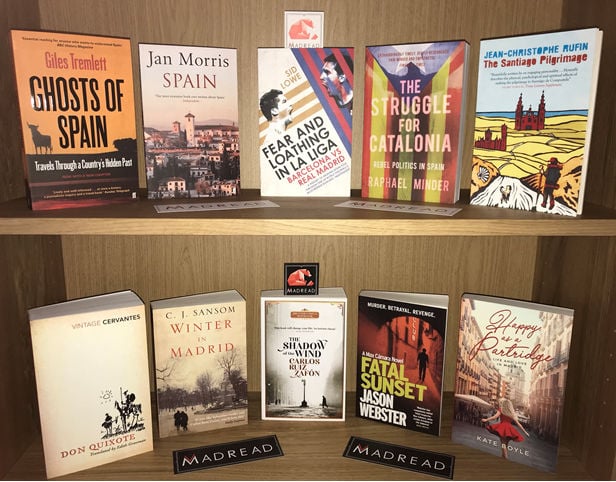
In addition to non-fiction titles there are also fiction books either set in Spain or originally written in Spanish that are fun for discovering new places and authors.
If you have already covered the essential reading my further reading suggestions will give you a little inspiration for what to read next. Something for everyone. I hope you find something that you like and discover something new.
NON-FICTION
Ghosts of Spain by Giles Tremlett
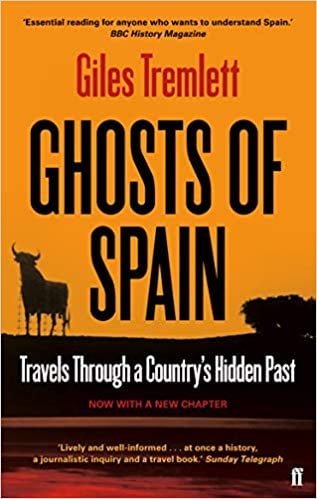
Giles Tremlett is an award-winning historian, author and journalist who moved to Spain in the nineties working as a correspondent for The Guardian and The Economist, as well as writing for a number of Spanish broadcasters.
At a moment when a number of mass graves containing the victims of Franco´s death squads were being discovered, the “pact of forgetting” began to break.
This prompted Tremlett to set off on a journey around Spain to gather his research for this book.
The book covers a number of topics that have shaped and influenced Spain over the twentieth century, including the Civil War, Basque terrorism, Catalans dislike for Madrid (to put it mildly), the more recent terrorist bombings in Madrid in 2004, as well as some lighter themes such as the invention of the bikini!
The detailed research and insightful interviews with Spaniards old and young from across the country makes this the perfect eye-opener for those just off the boat and provides little trinkets of knowledge for the more established settler.
I found the book difficult to read at first,when I was still living in the UK. Admittedly this was due to my limited investment in understanding the history of the country before I had moved here. Once I arrived, I picked it up again and couldn’t put it down until I had read it all. When you actually move to another country you become a lot more invested in understanding its people and its culture. At times I found myself saying out loud “Ohhhh I see!” And you will too.
Spain by Jan Morris
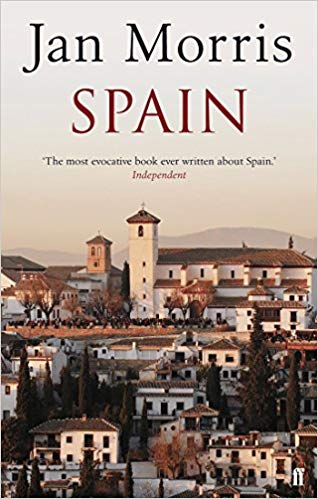
Jan Morris is a Welsh historian, a former correspondent for The Times and award winning travel-writer. She accompanied the British Mount Everest Expedition in 1953 and reported the success of Hillary and Tenzing in scaling Everest.
Described as the ‘most evocative book ever written about Spain’ Morris first wrote this book in 1967 and it was republished in 2008 with an updated foreword about the post-Franco era.
History, geography, religion, culture and politics are all covered using highly descriptive language to portray the chosen scene that takes the reader right there,to that moment, as if standing in the plaza with her as she sips a cafe con leche taking in the atmosphere.
“The first characteristic of Spain”, Morris writes. ´Here all is sol or sombra, sun or shade, as they call the two halves of the bull-ring. You are seldom half way in Spain. It is either fearfully hot or frightfully cold. You are either a good man or a bad one, either very rich or very poor, either a faithful church-goer or an out-and-out disbeliever.´
Regarding Spaniards themselves, Morris speaks of the diversity of the regions (or Kingdoms) of Spain and the strong feeling of patriotism they have for their territory.
Written in 1967, the book captures what it meant to be Spanish during the Franco era but it also goes on to say how much Spain has changed since then. More tourism, more motorways, small villages lost as people flocked to the cities.
But the feeling of being Spanish hasn’t changed. ´So when I say this book is about a particular Spanish time, perhaps it is about all Spanish times really´
This book is for those who enjoy the romanticism of Spain and the allure of its history, conflict and passion.
Fear and Loathing in La Liga by Sid Lowe
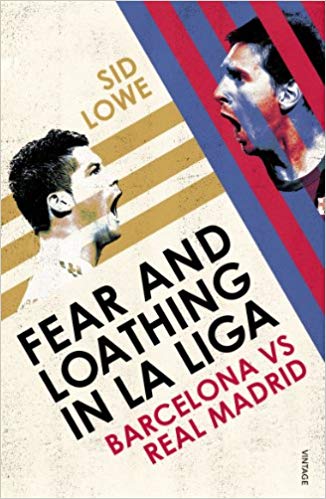
Football. You can’t avoid it in Spain. Any tapas bar you find yourself in will either have the television on in the background with a replay of an old Classico (the famous dual between the two largest biggest and most famous team in Spain, Real Madrid and Barcelona) or a group of people arguing about the current state of play in La Liga, the Spanish top tier football league.
“It's Messi vs Ronaldo, Catalonia vs Castilla. It’s the nation against the state, freedom fighters vs Franco’s fascists. It’s the best two teams on the planet going face to face and toe to toe. It’s more than a game. It’s a war. It’s Barcelona vs Real Madrid”.
Whilst this is mainly directed at football fans this book has an interesting mix of football history and Spanish history. It’s fascinating how the two intertwine to explain more than just the football rivalries but where they stem from and why at 17 minutes and 14 seconds into each Barcelona game the fans begin to chant.
This is not just excitement for the flair on the pitch, it’s recognition of the loss of Catalan independence in 1714, a topic that is more alive today than ever and provides a nice segue way into the next book...
The Struggle for Catalonia by Raphael Minder
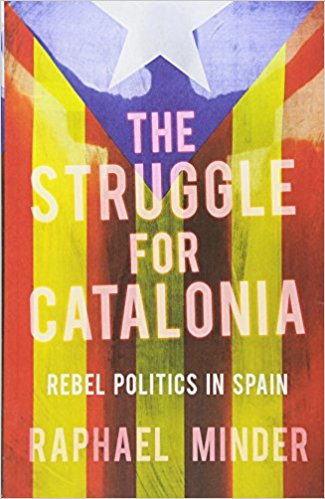
In light of the recent Catalonia independence referendum held in October 2017, this is a very timely book to be reading and has been quoted as ‘Deeply researched, fair-minded and empathetic’.
Raphael Minder is a Swiss journalist working as the New York Times correspondent for Spain and Portugal since 2010 covering issues including the financial crisis and the territorial conflict over Catalonia.
In his book, Minder dives into Catalonia’s history from 1714 and gradually brings the reader back to the present day to provide a comprehensive understanding of where Catalonia’s deep rooted sense of identity is derived from. In coverage of the referendum a common question asked was ‘What defines a country?’
According to rock musician Frank Zappa, the answer was it has to have a beer and an airline! However, international law experts identify four main characteristics. A people, a territory, a government and the ability to conduct relations with other states on a sovereign basis. Minder covers many of these themes and more in his book.
Whilst the violent clashes between protestors and the Civil Guard following the October referendum subsided, the underlying issues became more complicated than ever following the temporary reassertion of control over the autonomy by the central government.
With ongoing uncertainty in Catalonia, one thing is certain. Living in Spain, you will be questioned about this topic from friends and family back home.
This book will enable you to fend off those questions and also, perhaps, determine where you own opinion lies, which may already have been influenced simply by what part of this peninsular you have settled. Right or wrong? In or out? More questions are sure to arise in your mind, but you will find some answers here and that’s a start.
The Santiago Pilgrimage by Jean-Christophe Rufin
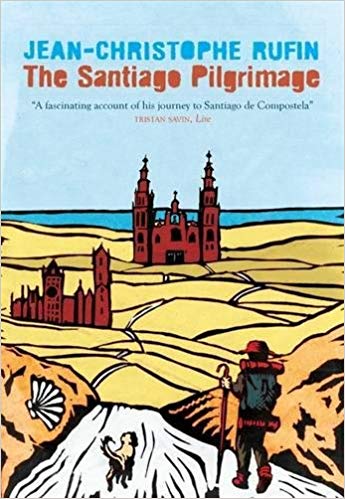
I know what you’re thinking. A book about Spain, written by a Frenchman? Well I will come to that. But first consider this. The Road to Santiago or El Camino is the most famous pilgrimage in Spain, if not the world.
The journey ending at the Cathedral of Santiago de Compostela in Galicia, north west Spain, and the reputed burial place of Saint James the Great, one of the apostles of Jesus Christ.
Also known as ‘the Way of Saint James’, although there is no single way, only a single end point. This is another element of Spanish culture and history that you simply cannot escape from, be it photos on Facebook of some friend of a friend who has decided to walk it, with a big smile as they set off with their brand new camping gear piled high on their back. Or a day trip to a nearby town and coming across a simple scallop shell on the ground with an arrow. Or driving along a road and passing what appears to be someone in fancy dress going to a Lord of the Rings themed party with a cape and a stick.
My point is that any book about ‘El Camino’ can only be written by somebody who has walked it and that’s what Rufin did.
Whilst clearly a significant undertaking for anybody to embark upon, what struck me most about Rufin’s account was how mundane much of the route is.
Needless to say there it requires a lot of walking(!),but I had always imagined the route as being ‘off road’ along picturesque coastal routes or along the ridge of hills and mountains with spectacular views.
A chance to escape modern life, clear your mind and meet interesting people. Due to the lack of any single route, the route you choose can be whatever you make it, but from the tale in this book there were very long stints along unremarkable roads.
This is perhaps unavoidable. Along an eight hundred kilometre trek I am fairly certain that I would reach a point where the quick route along the main road vs the slower scenic route would win out.
While Rufin walked there, this is not the only option and many also cycle. For a more humorous tale of ‘El Camino’ why not read Tim Moore’s ‘Travels with My Donkey’, which needs no further explanation.
Rufin chooses the ‘Northern Way’ as his route and encounters a host of fellow pilgrims, monks, locals, tough terrain and hostile wildlife.
Each year more and more people take up the challenge and in 2017 over three hundred thousand people completed it. If you decide you want to give it a go then this book is a must. Or if you prefer, like me, you can also discover the route from the comfort of you favourite armchair.
This book combines the romanticism of meeting interesting people, breathtaking views of sunsets, self-fulfilment and reminding yourself what stillness sounds like, with the reality of long slogs along black tarmac with nothing but your thoughts to keep you company. Insightful, thought-provoking and inspiring.
Banner ad
Further non-fiction recommendations
If you have read these already, then fear not. There is more where they came from. The MadRead shelves are stacked high with more fascinating reads about Spain. Here are just a few more to satisfy your curiosity…..
‘The Train in Spain’ by Christopher Howse; ‘Travellers in Spain’ by David Mitchell; ‘The Spanish Holocaust’by Paul Preston; ‘The Basque History of the World’ by Mark Kurlansky and ‘Driving Over Lemons’by Chris Stewart.
Let’s not also forget the most loved of all things Spanish…..the food! If you have a taste for cooking up a few Spanish dishes at home, why not try these cookbooks: ‘Barrafina’ by Sam and Eddie Hart and Nieves Barragán Mohacho; ‘Morito’by Sam Clark and‘Basque Country’by Marti Buckley.
READ ALSO: The 14 best books about the Spanish Civil War
FICTION
Don Quixote by Miguel Cervantes

I did say this article was about essential reading and it doesn’t get more essential than Don Quixote. Written by Miguel Cervantes and first published in 1605 (the Spanish Golden Age of flourishing art and literature) this is regarded as the world’s first modern novel and one of the funniest and most tragic books ever written. It has been translated into 145 languages and the Cervantes Institute says it is the most translated book after the Bible. Furthermore, this book has not been consigned to history but is more prevalent in today’s society than ever.
Spanish children across the country know this story inside out, much more so than an English primary school child can relay any story by Shakespeare. They learn it at school, perform it in plays and read it at home.
The noble knight errant and his famous adventures of bravery and courage alongside his faithful squire, Sancho Panza, as they travel through sixteenth century Spain are legendary.
There are many translations into English and while the interpretation from old Spanish into modern English makes the language at times a little tricky, the story is easy to follow and provides entertainment, laugh out loud moments and evokes empathy for the protagonist. What’s more, the story of Don Quixote is visible all around us.
Cervantes Week takes place around the writer’s baptism date on 9 October 1547 and plays host to a number of events, lectures, theatrical performances, concerts, gastronomic events and markets.
Go to Alcalá de Henares, the birthplace of Cervantes, just outside Madrid, and you would be forgiven for thinking this was a worldwide phenomenon, as it takes over the town. Stop by the barrio de Las Letras in Madrid and on Saturdays you are certain to be knocked over by tourist groups walking down Calle de Cervantes to take a selfie outside Cervantes´ home, as though a modern day film star in the Hollywood hills.
The Plaza de España hosts a charming statue of Don Quixote riding his stallion Rocinante alongside Sancho Panza.
You can even follow in the footsteps of Don Quixote’s route around Spain and joust with the windmills if it pleases you. Spain is littered with statues of Cervantes and his famous characters. It doesn’t even stop there.At every location referenced in this book, they have erected or show proud Cervantine references from as far away as Panama and San Francisco.
If you have read it or if this seems like an obvious choice, then please accept my humble apologies. If you haven’t, pick up a copy now because …. it is essential. Any article without this book as the number one book of fiction to read when living in Spain would be a crime against literature that would prompt Don Quixote to take up his sword and fight to the death to restore honour.
The Shadow of the Wind by Carlos Ruiz Zafón
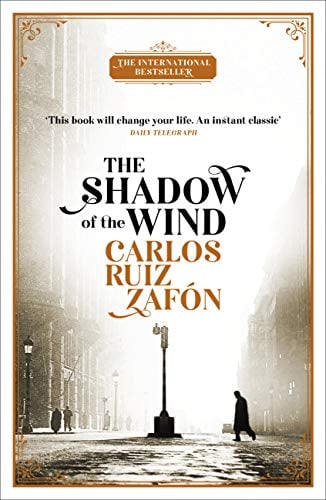
This is the first book in the ‘Cemetery of Forgotten Books’ series and what a book it is! 10 year old Daniel is taken to the Cemetery of Forgotten Books by his father, a bookseller in Barcelona, where he chooses The Shadow of the Wind by Julian Carax. As he grows up, he finds people becoming interested in his chosen book, leading Daniel to search for the truth about the life and death of Julian Carax.
Set in the 1940’s during a dark period in Barcelona, in addition to the gripping plot that keeps you awake late at night to read ‘just one more chapter’, this book also gives you a sense of what Barcelona was like in those times. The uncertainty, fear and oppression that are brought to life through the characters.
This is one of my favourite fictional books set in Spain. What I enjoyed most about ‘The Shadow of the Wind’ was how my opinions of each of the characters changed throughout the book as Zafón gradually reveals a little more of their pasts. Once I got to grips with the parallel stories of past, present and the book within the book, I was completely hooked on finding out how each storyline progressed and seeing how they weaved together.
There are now three more books in the series, starting with the ‘Angels Game’, ‘The Prisoner of Heaven’and recently published ‘Labyrinth of the Spirits’. Once you get hooked on the first, you will be sure to want to read the rest.
Winter in Madrid by C.J.Sansom
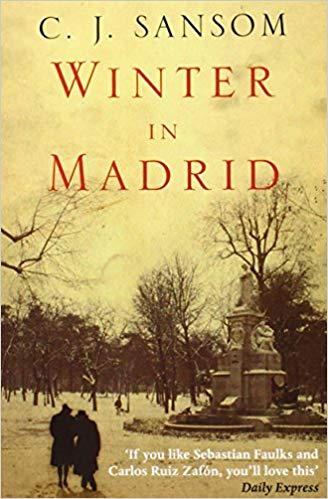
Winter in Madrid is set during the Spanish civil war and is the tale of three English school friends who all find themselves in Spain during this horrific period of the country's history. This book is packed full of sub-plots with romance, friendship, spying, surviving and suffering that really gives the reader a feel for how it would have been like to live in the Spanish capital during those times.
The descriptions in this book are vivid and immerse you in the moment, feeling the cold and the uncertainty around you. In the epilogue we learn that the prisoner of war camp in Cuenca was fictional, albeit based on accounts of other similar camps. The conditions were truly awful and the prisoners fear of the guards was very apparent, flinching as they expect to be hit and knowing their limits with each individual guard.
There are many references to institutions in Madrid that are still there today, such as Cafe Gijón, where I frequently enjoy a menu del día. For anyone living in Madrid, this book will make you look at the city in a very different light and helps a great deal to understand its past.
Sansom has clearly taken every measure to portray history accurately and finding the pockets where he could enter the fictional elements of his story. Again, reading the epilogue was fascinating to see how he admittedly moulds a few historical facts to fit the plot. Something I love about historical fiction is how you learn more about something or somebody that you know from your history lessons at school and get a greater insight into their behaviour and traits through the storyline as though you are there in that moment in time with them. A really great read, a must for anyone living in Madrid or with an interest in the control of European power during the 1930´s.
Fatal Sunset by Jason Webster
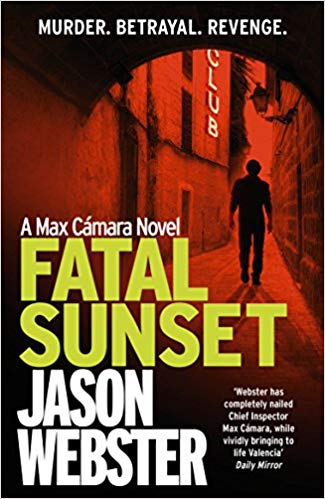
Jason Webster was born in San Francisco, educated at Oxford University where he studied Arabic and Islamic history, and has lived in Spain for many years. He has written a number of novels and ‘Fatal Sunset’is the latest in his Max Cámara crime novels. The first in this series, ‘Or the Bull Kills You’was longlisted for the CWA Crime Thriller Awards New Blood Dagger in 2011.
Set in Valencia, the owner of a well known nightclub is assumed to have died from a heart attack. Cámara is pulled away from his investigation to look into what appeared to be a natural death, when an anonymous tip off suggests otherwise. Meanwhile his journalist girlfriend is pursuing a big story that leads her enquiries to the same nightclub to uncover a government secret and puts both of their lives in danger.
Banner ad
Webster has something for everyone. If you enjoy a good crime novel, there are 5 preceding books in the Max Cámara series. He has also written non-fiction books about Spain including ‘Duende: A Journey in Search of Flamenco’; ‘Andalus: Unlocking the Secrets of Moorish Spain’; ‘Guerra: Living in the Shadows of the Spanish Civil War’; ‘Sacred Sierra: A Year on a Spanish Mountain’and ‘The Spy with 29 Names’,the story of Juan Pujol, the man with the reputation as the most successful double agent of World War II. That should keep you going for a while!
Happy as a Partridge by Kate Boyle
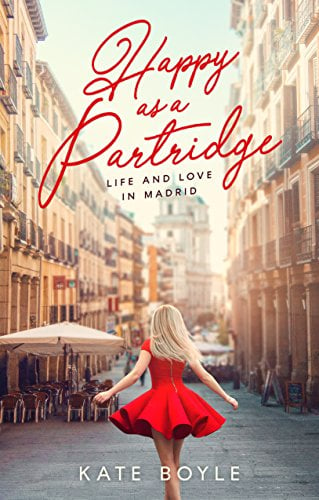
To finish off, I recommend something a little more light-hearted and current. A great book about a life changing adventure everyone should experience. Evie Fuller is fed up of her life in London, so moves to Madrid. This book kept me very entertained due to the countless examples of adapting to Spanish life that I can relate to. From the feeling that your Spanish never gets any better and that surely you should be fluent by now, to the hysterical mispronunciations the Spanish make when speaking English, which Evie has to correct as part of her job as an English teacher.
There are many laugh out loud moments but my favourite was when she spots "the crazy old man cutting some serious shapes whilst listening to his headphones, oblivious to those watching and laughing". I have seen this guy in the park and he makes me smile every time! Who wouldn’t want to be him in their old age?
One of the points I noted was how Evie was unimpressed with Madrid upon her arrival. It’s not Paris or Rome. However, as Evie spends more time in Madrid and struggles through the difficulties of adapting to her new life, she comes to see the detail in everyday things she never noticed at first that ultimately enchants how she views her new home.
The debut novel from Boyle is a fun, entertaining and highly relatable experience of life and love in Madrid.
A version of this article was first published in October 2018
READ MORE: The ultimate binge-watch bucket list of Spanish box-sets
Comments
See Also
Adam García, founder of MadRead,shares his top ten essential reads with The Local readers.
In some ways, Spain is a very familiar country. The Iberian Peninsular is a common holiday destination for most Europeans and you may have visited prior to making the move to live here. Yet in other ways, Spain is unlike any other country on earth.
It has a complicated and partly ‘forgotten’ history full of conflict, be it due to power, politics, territory, invasion, persecution, family and yes of course, football.
This complex past results in subtle comments and attitudes from Spaniards that are difficult to understand without a good understanding of their origins.
Reading is the best way to achieve that understanding, but ... ten cuidado (be careful)! History is only told by those who survive it and can be slanted to portray the teller’s personal opinions rather than fact, but this is human nature. The only way to overcome any bias is to read widely, from different sources, points of view and periods in time.
I have been living in Madrid for a little over two years now. To some of you this may seem like an eternity, whilst to others I am fresh off the boat. Whichever applies, I have chosen a selection of books that I hope will help you to navigate through the illustrious past and present of your chosen destination, Spain, no matter how long you have been here.

In addition to non-fiction titles there are also fiction books either set in Spain or originally written in Spanish that are fun for discovering new places and authors.
If you have already covered the essential reading my further reading suggestions will give you a little inspiration for what to read next. Something for everyone. I hope you find something that you like and discover something new.
NON-FICTION
Ghosts of Spain by Giles Tremlett

Giles Tremlett is an award-winning historian, author and journalist who moved to Spain in the nineties working as a correspondent for The Guardian and The Economist, as well as writing for a number of Spanish broadcasters.
At a moment when a number of mass graves containing the victims of Franco´s death squads were being discovered, the “pact of forgetting” began to break.
This prompted Tremlett to set off on a journey around Spain to gather his research for this book.
The book covers a number of topics that have shaped and influenced Spain over the twentieth century, including the Civil War, Basque terrorism, Catalans dislike for Madrid (to put it mildly), the more recent terrorist bombings in Madrid in 2004, as well as some lighter themes such as the invention of the bikini!
The detailed research and insightful interviews with Spaniards old and young from across the country makes this the perfect eye-opener for those just off the boat and provides little trinkets of knowledge for the more established settler.
I found the book difficult to read at first,when I was still living in the UK. Admittedly this was due to my limited investment in understanding the history of the country before I had moved here. Once I arrived, I picked it up again and couldn’t put it down until I had read it all. When you actually move to another country you become a lot more invested in understanding its people and its culture. At times I found myself saying out loud “Ohhhh I see!” And you will too.
Spain by Jan Morris

Jan Morris is a Welsh historian, a former correspondent for The Times and award winning travel-writer. She accompanied the British Mount Everest Expedition in 1953 and reported the success of Hillary and Tenzing in scaling Everest.
Described as the ‘most evocative book ever written about Spain’ Morris first wrote this book in 1967 and it was republished in 2008 with an updated foreword about the post-Franco era.
History, geography, religion, culture and politics are all covered using highly descriptive language to portray the chosen scene that takes the reader right there,to that moment, as if standing in the plaza with her as she sips a cafe con leche taking in the atmosphere.
“The first characteristic of Spain”, Morris writes. ´Here all is sol or sombra, sun or shade, as they call the two halves of the bull-ring. You are seldom half way in Spain. It is either fearfully hot or frightfully cold. You are either a good man or a bad one, either very rich or very poor, either a faithful church-goer or an out-and-out disbeliever.´
Regarding Spaniards themselves, Morris speaks of the diversity of the regions (or Kingdoms) of Spain and the strong feeling of patriotism they have for their territory.
Written in 1967, the book captures what it meant to be Spanish during the Franco era but it also goes on to say how much Spain has changed since then. More tourism, more motorways, small villages lost as people flocked to the cities.
But the feeling of being Spanish hasn’t changed. ´So when I say this book is about a particular Spanish time, perhaps it is about all Spanish times really´
This book is for those who enjoy the romanticism of Spain and the allure of its history, conflict and passion.
Fear and Loathing in La Liga by Sid Lowe

Football. You can’t avoid it in Spain. Any tapas bar you find yourself in will either have the television on in the background with a replay of an old Classico (the famous dual between the two largest biggest and most famous team in Spain, Real Madrid and Barcelona) or a group of people arguing about the current state of play in La Liga, the Spanish top tier football league.
“It's Messi vs Ronaldo, Catalonia vs Castilla. It’s the nation against the state, freedom fighters vs Franco’s fascists. It’s the best two teams on the planet going face to face and toe to toe. It’s more than a game. It’s a war. It’s Barcelona vs Real Madrid”.
Whilst this is mainly directed at football fans this book has an interesting mix of football history and Spanish history. It’s fascinating how the two intertwine to explain more than just the football rivalries but where they stem from and why at 17 minutes and 14 seconds into each Barcelona game the fans begin to chant.
This is not just excitement for the flair on the pitch, it’s recognition of the loss of Catalan independence in 1714, a topic that is more alive today than ever and provides a nice segue way into the next book...
The Struggle for Catalonia by Raphael Minder

In light of the recent Catalonia independence referendum held in October 2017, this is a very timely book to be reading and has been quoted as ‘Deeply researched, fair-minded and empathetic’.
Raphael Minder is a Swiss journalist working as the New York Times correspondent for Spain and Portugal since 2010 covering issues including the financial crisis and the territorial conflict over Catalonia.
In his book, Minder dives into Catalonia’s history from 1714 and gradually brings the reader back to the present day to provide a comprehensive understanding of where Catalonia’s deep rooted sense of identity is derived from. In coverage of the referendum a common question asked was ‘What defines a country?’
According to rock musician Frank Zappa, the answer was it has to have a beer and an airline! However, international law experts identify four main characteristics. A people, a territory, a government and the ability to conduct relations with other states on a sovereign basis. Minder covers many of these themes and more in his book.
Whilst the violent clashes between protestors and the Civil Guard following the October referendum subsided, the underlying issues became more complicated than ever following the temporary reassertion of control over the autonomy by the central government.
With ongoing uncertainty in Catalonia, one thing is certain. Living in Spain, you will be questioned about this topic from friends and family back home.
This book will enable you to fend off those questions and also, perhaps, determine where you own opinion lies, which may already have been influenced simply by what part of this peninsular you have settled. Right or wrong? In or out? More questions are sure to arise in your mind, but you will find some answers here and that’s a start.
The Santiago Pilgrimage by Jean-Christophe Rufin

I know what you’re thinking. A book about Spain, written by a Frenchman? Well I will come to that. But first consider this. The Road to Santiago or El Camino is the most famous pilgrimage in Spain, if not the world.
The journey ending at the Cathedral of Santiago de Compostela in Galicia, north west Spain, and the reputed burial place of Saint James the Great, one of the apostles of Jesus Christ.
Also known as ‘the Way of Saint James’, although there is no single way, only a single end point. This is another element of Spanish culture and history that you simply cannot escape from, be it photos on Facebook of some friend of a friend who has decided to walk it, with a big smile as they set off with their brand new camping gear piled high on their back. Or a day trip to a nearby town and coming across a simple scallop shell on the ground with an arrow. Or driving along a road and passing what appears to be someone in fancy dress going to a Lord of the Rings themed party with a cape and a stick.
My point is that any book about ‘El Camino’ can only be written by somebody who has walked it and that’s what Rufin did.
Whilst clearly a significant undertaking for anybody to embark upon, what struck me most about Rufin’s account was how mundane much of the route is.
Needless to say there it requires a lot of walking(!),but I had always imagined the route as being ‘off road’ along picturesque coastal routes or along the ridge of hills and mountains with spectacular views.
A chance to escape modern life, clear your mind and meet interesting people. Due to the lack of any single route, the route you choose can be whatever you make it, but from the tale in this book there were very long stints along unremarkable roads.
This is perhaps unavoidable. Along an eight hundred kilometre trek I am fairly certain that I would reach a point where the quick route along the main road vs the slower scenic route would win out.
While Rufin walked there, this is not the only option and many also cycle. For a more humorous tale of ‘El Camino’ why not read Tim Moore’s ‘Travels with My Donkey’, which needs no further explanation.
Rufin chooses the ‘Northern Way’ as his route and encounters a host of fellow pilgrims, monks, locals, tough terrain and hostile wildlife.
Each year more and more people take up the challenge and in 2017 over three hundred thousand people completed it. If you decide you want to give it a go then this book is a must. Or if you prefer, like me, you can also discover the route from the comfort of you favourite armchair.
This book combines the romanticism of meeting interesting people, breathtaking views of sunsets, self-fulfilment and reminding yourself what stillness sounds like, with the reality of long slogs along black tarmac with nothing but your thoughts to keep you company. Insightful, thought-provoking and inspiring.
| Banner ad |
Further non-fiction recommendations
If you have read these already, then fear not. There is more where they came from. The MadRead shelves are stacked high with more fascinating reads about Spain. Here are just a few more to satisfy your curiosity…..
‘The Train in Spain’ by Christopher Howse; ‘Travellers in Spain’ by David Mitchell; ‘The Spanish Holocaust’by Paul Preston; ‘The Basque History of the World’ by Mark Kurlansky and ‘Driving Over Lemons’by Chris Stewart.
Let’s not also forget the most loved of all things Spanish…..the food! If you have a taste for cooking up a few Spanish dishes at home, why not try these cookbooks: ‘Barrafina’ by Sam and Eddie Hart and Nieves Barragán Mohacho; ‘Morito’by Sam Clark and‘Basque Country’by Marti Buckley.
READ ALSO: The 14 best books about the Spanish Civil War
FICTION
Don Quixote by Miguel Cervantes

I did say this article was about essential reading and it doesn’t get more essential than Don Quixote. Written by Miguel Cervantes and first published in 1605 (the Spanish Golden Age of flourishing art and literature) this is regarded as the world’s first modern novel and one of the funniest and most tragic books ever written. It has been translated into 145 languages and the Cervantes Institute says it is the most translated book after the Bible. Furthermore, this book has not been consigned to history but is more prevalent in today’s society than ever.
Spanish children across the country know this story inside out, much more so than an English primary school child can relay any story by Shakespeare. They learn it at school, perform it in plays and read it at home.
The noble knight errant and his famous adventures of bravery and courage alongside his faithful squire, Sancho Panza, as they travel through sixteenth century Spain are legendary.
There are many translations into English and while the interpretation from old Spanish into modern English makes the language at times a little tricky, the story is easy to follow and provides entertainment, laugh out loud moments and evokes empathy for the protagonist. What’s more, the story of Don Quixote is visible all around us.
Cervantes Week takes place around the writer’s baptism date on 9 October 1547 and plays host to a number of events, lectures, theatrical performances, concerts, gastronomic events and markets.
Go to Alcalá de Henares, the birthplace of Cervantes, just outside Madrid, and you would be forgiven for thinking this was a worldwide phenomenon, as it takes over the town. Stop by the barrio de Las Letras in Madrid and on Saturdays you are certain to be knocked over by tourist groups walking down Calle de Cervantes to take a selfie outside Cervantes´ home, as though a modern day film star in the Hollywood hills.
The Plaza de España hosts a charming statue of Don Quixote riding his stallion Rocinante alongside Sancho Panza.
You can even follow in the footsteps of Don Quixote’s route around Spain and joust with the windmills if it pleases you. Spain is littered with statues of Cervantes and his famous characters. It doesn’t even stop there.At every location referenced in this book, they have erected or show proud Cervantine references from as far away as Panama and San Francisco.
If you have read it or if this seems like an obvious choice, then please accept my humble apologies. If you haven’t, pick up a copy now because …. it is essential. Any article without this book as the number one book of fiction to read when living in Spain would be a crime against literature that would prompt Don Quixote to take up his sword and fight to the death to restore honour.
The Shadow of the Wind by Carlos Ruiz Zafón

This is the first book in the ‘Cemetery of Forgotten Books’ series and what a book it is! 10 year old Daniel is taken to the Cemetery of Forgotten Books by his father, a bookseller in Barcelona, where he chooses The Shadow of the Wind by Julian Carax. As he grows up, he finds people becoming interested in his chosen book, leading Daniel to search for the truth about the life and death of Julian Carax.
Set in the 1940’s during a dark period in Barcelona, in addition to the gripping plot that keeps you awake late at night to read ‘just one more chapter’, this book also gives you a sense of what Barcelona was like in those times. The uncertainty, fear and oppression that are brought to life through the characters.
This is one of my favourite fictional books set in Spain. What I enjoyed most about ‘The Shadow of the Wind’ was how my opinions of each of the characters changed throughout the book as Zafón gradually reveals a little more of their pasts. Once I got to grips with the parallel stories of past, present and the book within the book, I was completely hooked on finding out how each storyline progressed and seeing how they weaved together.
There are now three more books in the series, starting with the ‘Angels Game’, ‘The Prisoner of Heaven’and recently published ‘Labyrinth of the Spirits’. Once you get hooked on the first, you will be sure to want to read the rest.
Winter in Madrid by C.J.Sansom

Winter in Madrid is set during the Spanish civil war and is the tale of three English school friends who all find themselves in Spain during this horrific period of the country's history. This book is packed full of sub-plots with romance, friendship, spying, surviving and suffering that really gives the reader a feel for how it would have been like to live in the Spanish capital during those times.
The descriptions in this book are vivid and immerse you in the moment, feeling the cold and the uncertainty around you. In the epilogue we learn that the prisoner of war camp in Cuenca was fictional, albeit based on accounts of other similar camps. The conditions were truly awful and the prisoners fear of the guards was very apparent, flinching as they expect to be hit and knowing their limits with each individual guard.
There are many references to institutions in Madrid that are still there today, such as Cafe Gijón, where I frequently enjoy a menu del día. For anyone living in Madrid, this book will make you look at the city in a very different light and helps a great deal to understand its past.
Sansom has clearly taken every measure to portray history accurately and finding the pockets where he could enter the fictional elements of his story. Again, reading the epilogue was fascinating to see how he admittedly moulds a few historical facts to fit the plot. Something I love about historical fiction is how you learn more about something or somebody that you know from your history lessons at school and get a greater insight into their behaviour and traits through the storyline as though you are there in that moment in time with them. A really great read, a must for anyone living in Madrid or with an interest in the control of European power during the 1930´s.
Fatal Sunset by Jason Webster

Jason Webster was born in San Francisco, educated at Oxford University where he studied Arabic and Islamic history, and has lived in Spain for many years. He has written a number of novels and ‘Fatal Sunset’is the latest in his Max Cámara crime novels. The first in this series, ‘Or the Bull Kills You’was longlisted for the CWA Crime Thriller Awards New Blood Dagger in 2011.
Set in Valencia, the owner of a well known nightclub is assumed to have died from a heart attack. Cámara is pulled away from his investigation to look into what appeared to be a natural death, when an anonymous tip off suggests otherwise. Meanwhile his journalist girlfriend is pursuing a big story that leads her enquiries to the same nightclub to uncover a government secret and puts both of their lives in danger.
| Banner ad |
Webster has something for everyone. If you enjoy a good crime novel, there are 5 preceding books in the Max Cámara series. He has also written non-fiction books about Spain including ‘Duende: A Journey in Search of Flamenco’; ‘Andalus: Unlocking the Secrets of Moorish Spain’; ‘Guerra: Living in the Shadows of the Spanish Civil War’; ‘Sacred Sierra: A Year on a Spanish Mountain’and ‘The Spy with 29 Names’,the story of Juan Pujol, the man with the reputation as the most successful double agent of World War II. That should keep you going for a while!
Happy as a Partridge by Kate Boyle

To finish off, I recommend something a little more light-hearted and current. A great book about a life changing adventure everyone should experience. Evie Fuller is fed up of her life in London, so moves to Madrid. This book kept me very entertained due to the countless examples of adapting to Spanish life that I can relate to. From the feeling that your Spanish never gets any better and that surely you should be fluent by now, to the hysterical mispronunciations the Spanish make when speaking English, which Evie has to correct as part of her job as an English teacher.
There are many laugh out loud moments but my favourite was when she spots "the crazy old man cutting some serious shapes whilst listening to his headphones, oblivious to those watching and laughing". I have seen this guy in the park and he makes me smile every time! Who wouldn’t want to be him in their old age?
One of the points I noted was how Evie was unimpressed with Madrid upon her arrival. It’s not Paris or Rome. However, as Evie spends more time in Madrid and struggles through the difficulties of adapting to her new life, she comes to see the detail in everyday things she never noticed at first that ultimately enchants how she views her new home.
The debut novel from Boyle is a fun, entertaining and highly relatable experience of life and love in Madrid.
A version of this article was first published in October 2018
READ MORE: The ultimate binge-watch bucket list of Spanish box-sets
Join the conversation in our comments section below. Share your own views and experience and if you have a question or suggestion for our journalists then email us at [email protected].
Please keep comments civil, constructive and on topic – and make sure to read our terms of use before getting involved.
Please log in here to leave a comment.